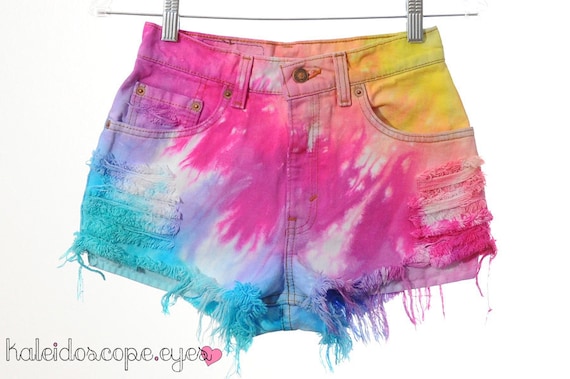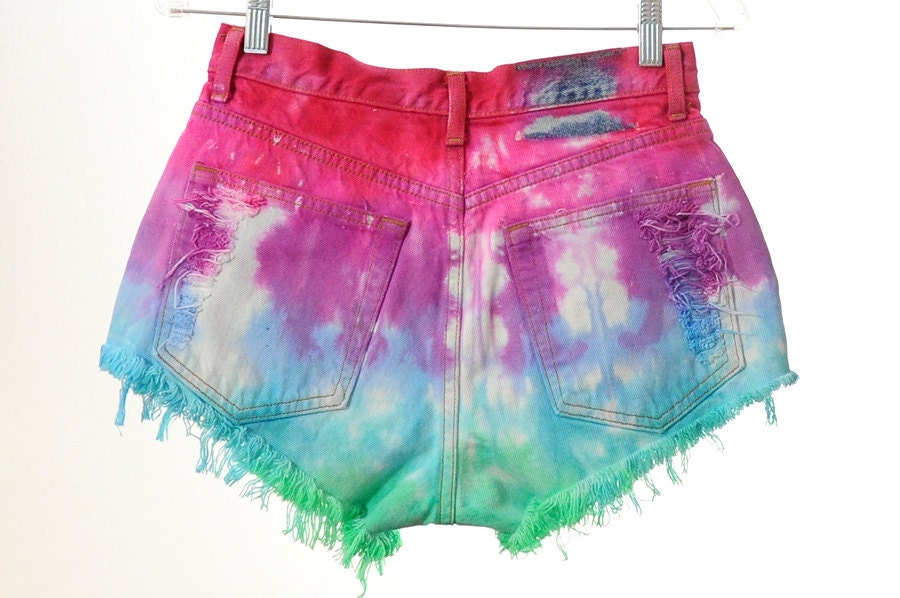How are these tie-dye effects achieved?
Name: Ore
Country or region: United Kingdom
Message: Hello there,
My name is Ore and I have a burning thought/question and I hope you can help as I have thought for ages about this...How are these effects achieved? Is it through accordian folding and bulldog clips? Is it from resist bleach? Or is it through laying the garment flat, clipping some sections and then just using squirt bottles to cover the jeans? I'm dying to know, I hope you can tell me how it's done. I have attached the links below. Thank you. Really hope to hear from you soon.




Aside from the intentional holes and other damage to the fabric of the garments, those look very ordinary to me, very much like my first efforts at dyeing with a good tie-dyeing kit containing Procion MX dyes. The turquoise, fuchsia, and yellow are the most commonly used of all the Procion MX dye colors, straight out of the kit, while the blue, violet, and peach are the result of combinations of two of the three colors where they overlapped on the fabric, along with some additional dilution, probably from a large amount of liquid remaining in the garments from the soda ash pre-soak.
The first pair appears to have been loosely accordian-pleated with diagonal folds, probably tied loosely with rubber bands, presoaked in soda ash, and then a simple rainbow pattern applied across the folds, with a stripe of turquoise on the lower left leg of the shorts, fuchsia in the middle, and yellow at the upper right edge of the shorts, with orange where the yellow and fuchsia overlap, and purple and blue where the turquoise and fuchsia overlap. You can't get much more basic than that, once you start with a decent tie-dyeing kit.
The second pair appears to have been presoaked in soda ash, spread out flat, and had the dyes squirted on it. I don't think it was tied or clipped in any way. The edges of the pink stripe show the characteristic shapes that fuchsia (Procion Red MX-8B) tends to leave as it reacts with the fiber more quickly than the other colors. The other colors react more slowly, so they have more time to spread out smoothly. It's a nice effect that fuchsia leaves, which you can avoid, when you don't want it, by substituting a different red, Procion Red MX-5B. Unfortunately, it is more difficult to get other colors to mimic the fuchsia effect.
The other two pairs were made with similar techniques, though a red or a green may have been pre-mixed in a plastic bottle before application. If you have spare bottles, it's easy to mix any two of your other colors together to make a new color.
No bulldog clips appear to have been used. None of the binding appears to have been done tightly, as bulldog clips would. Any bleach was applied and washed out before the dye was ever involved; the shorts may have been both whitened and damaged by bleach, but the dyes have not been discharged. Discharged dyes do not just disappear, they also leave traces of themselves with more subtle, ghostly colors, as the results of the broken dye molecules that are left by bleach. That hasn't been done here.
This would be an ideal project for a first-time tie-dyer. Let me encourage you to try it for yourself. Whatever clothing you choose to dye should be white in color, and pre-washed thoroughly; its fiber content should be 100% cotton, with no polyester, or at least not much. Buy a good tie-dyeing kit, such as the ones sold in the US by PRO Chemical & Dye or Dharma Trading Company, or the Jacquard Products tie-dyeing kit, which is the very best of the tie-dyeing kits that you might be able to find in a local crafts or fabric store. Since you're in the UK, I encourage you to order a Procion MX tie-dyeing kit from George Weil or Kemtex Educational Supplies, or separately order the dyes Procion Yellow MX-8G or Procion Yellow MX-4G, Procion Red MX-8B, and Procion Turquoise MX-G, along with soda ash or washing soda, sodium hexametaphosphate as a water softener, rubber bands, plastic gloves, and plastic squeeze bottles with the pointy Yorker tips. George Weil does sell the small Funky Groovy Tie Dye Kit, made by Jacquard Products. For instructions, see the pages "Hand Dyeing - How to Do It: basic recipe for Procion MX dyes on cellulose or silk", and "How to Tie Dye - Complete Instructions".
(Please help support this web site. Thank you.)
(Please help support this web site. Thank you.)
Posted: Thursday - October 27, 2011 at 09:15 AM
Follow this blog on twitter here.
Quick Links
- All About Dyes & Dyeing Top -
- Top of this blog -
- FAQ -
- The Dye Forum -
- How to Tie Dye - How to Batik -
- Books - Toys - Plants -
- Top of this blog -
- FAQ -
- The Dye Forum -
- How to Tie Dye - How to Batik -
- Books - Toys - Plants -
More in this category:
- -
Statistics
Total entries in this blog:
Total entries in this category:
Published On: Aug 29, 2012 02:49 PM
Total entries in this category:
Published On: Aug 29, 2012 02:49 PM